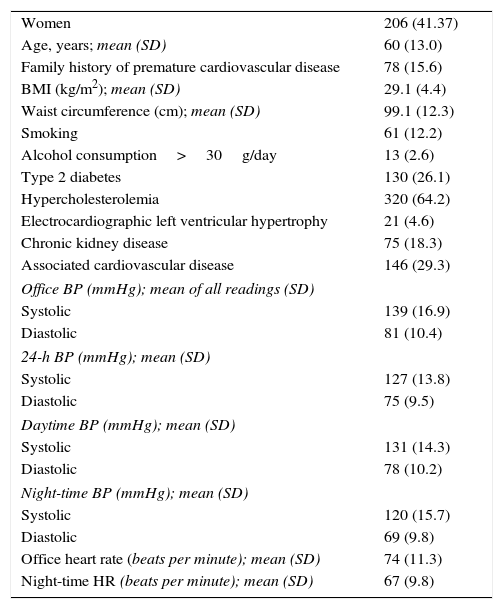The reported prevalence of masked uncontrolled hypertension (MUCH) varies because many studies are not comparable as they use different measurement methodologies. To evaluate the influence of the number of office blood pressure readings on the prevalence of MUCH we conducted a cross-sectional, multicenter study in treated hypertensive patients.
Patients and methodsWe carried out an observational, cross-sectional, multicenter study in 33 Spanish hospital-based hypertension units, involving 35 investigators and 12 Autonomous Communities. Six blood pressure readings and a 24-h ambulatory blood pressure monitoring were performed in treated hypertensive patients. The means of the first 3 readings (P123), the 2nd, 3rd and 4th readings (P234), the 3rd, 4th and 5th readings (P345) and the last 3 readings (P456) were compared with mean 24-h blood pressure. MUCH was defined as office blood pressure <140/90mmHg and 24-h blood pressure ≥130/80mmHg, considering the first 3 readings (MUCH123), the 2nd, 3rd and 4th readings (MUCH234), the 3rd, 4th and 5th readings (MUCH345) and the last 3 readings (MUCH456).
ResultsWe included 498 hypertensive patients. Mean (standard deviation) office blood pressure measurements were: (P123) 141(18)/82(11); (P234) 139(17)/81(11); (P345) 138(17)/81(11) and (P456) 137(16)/80(10) mmHg. Mean 24-h blood pressure was 127(13.8)/75(9.5) mmHg. The correlation coefficients between ambulatory and office systolic/diastolic blood pressure were (P123):0.48/0.50; (P234):0.50/0.52; (P345):0.50/0.54; and (P456):0.50/0.55 (p<0.001, all). The prevalences of MUCH123, MUCH234, MUCH345 and MUCH456 were 14.5%, 18.9%, 19.5% and 21.1%, respectively.
ConclusionsThe prevalence of MUCH diagnosis depends on the serial office blood pressure readings, being much higher for the last three blood pressure readings. Discarding the first and second office blood pressure measures seems to be the most accurate method for diagnosing MUCH.
Los datos sobre prevalencia de hipertensión arterial enmascarada no controlada (HTAE) son muy variables, ya que los registros obtenidos en diferentes estudios no son comparables al emplear diferentes mèc)todos de medición. Se llevó a cabo un estudio transversal y multicèc)ntrico en pacientes hipertensos tratados para evaluar la influencia de la cantidad de lecturas de la presión arterial en consulta sobre la prevalencia de la HTAE.
Pacientes y mèc)todosSe realizó un estudio observacional, transversal y multicèc)ntrico en 33 unidades de hipertensión en hospitales españoles, con la participación de 35 investigadores y 12 comunidades autónomas. Se realizaron 6 lecturas de la presión arterial y un control de la presión arterial ambulatoria de 24h en pacientes hipertensos tratados. Se compararon las medias de las 3 primeras lecturas (P123), de las lecturas 2, 3 y 4 (P234), de las lecturas 3, 4 y 5 (P345) y de las 3 últimas lecturas (P456) con la media de la presión arterial a las 24h. Teniendo en cuenta las 3 primeras lecturas (HTAE123), las lecturas segunda, tercera y cuarta (HTAE234), tercera, cuarta y quinta (HTAE345) y las últimas 3 lecturas (HTAE456); definimos la HTAE como una presión arterial en consulta <140/90mmHg y una presión arterial de 24h ≥130/80mmHg.
ResultadosSe incluyeron 498 pacientes hipertensos. La media de las mediciones (desviación estándar) de presión arterial en consulta fueron: (P123) 141 (18)/82 (11); (P234) 139 (17)/81 (11); (P345) 138 (17)/81 (11) y (P456) 137 (16)/80 (10) mmHg. La presión arterial media a las 24h fue de 127 (13.8)/75 (9.5) mmHg. Los coeficientes de correlación entre presión sistólica/presión diastólica ambulatoria y en consulta fueron (P123): 0.48/0.50; (P234): 0.50/0.52; (P345): 0.50/0.54; y (P456): 0.50/0.55 (p<0.001 de todos). Las prevalencias de HTAE123, HTAE234, HTAE345 y HTAE456 fueron 14.5%, 18.9%, 19.5% y 21.1%, respectivamente.
ConclusionesLa prevalencia de diagnóstico de HTAE depende de las series de lecturas de la presión arterial en consulta, siendo esta mucho más alta en las 3 últimas lecturas. Si descartamos la primera y segunda lecturas, la medida de la presión arterial en consulta parece ser el mèc)todo más preciso para el diagnóstico de la HTAE.
Article
Diríjase desde aquí a la web de la >>>FESEMI<<< e inicie sesión mediante el formulario que se encuentra en la barra superior, pulsando sobre el candado.

Una vez autentificado, en la misma web de FESEMI, en el menú superior, elija la opción deseada.

>>>FESEMI<<<










